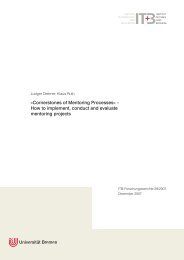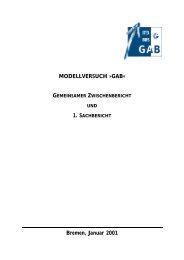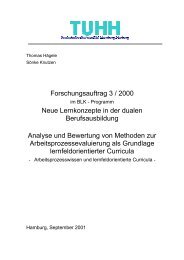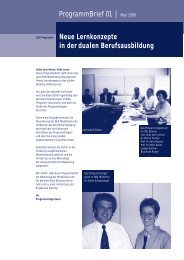VET Teacher Training in Australia: Preserving Australian VET ...
VET Teacher Training in Australia: Preserving Australian VET ...
VET Teacher Training in Australia: Preserving Australian VET ...
Create successful ePaper yourself
Turn your PDF publications into a flip-book with our unique Google optimized e-Paper software.
expected to be work‐ready; whereas, it is acceptable for a university graduate to be prepared to<br />
beg<strong>in</strong> to become work‐effective. Over time, the <strong>VET</strong> graduate expands their depth of theoretical<br />
understand<strong>in</strong>g and critical th<strong>in</strong>k<strong>in</strong>g and the university graduate, over time, catches up with the<br />
practical stuff. As purposeful learners (if such is nurtured), they both f<strong>in</strong>ish up <strong>in</strong> much the same<br />
amalgams of theory and practice place as is appropriate to their work.<br />
Cause and effect of casualisation of the <strong>VET</strong> teacher workforce<br />
In an April 2011 report, the <strong>Australia</strong>n Productivity Commission found that approximately one <strong>in</strong><br />
every four tra<strong>in</strong>ers or assessors 2 has more than one job and about 33% of non‐TAFE 3 tra<strong>in</strong>ers and<br />
assessors were employed on a part‐time basis and this percentage was likely to be higher <strong>in</strong> the<br />
TAFE sector (PC 2011, p.31).<br />
Although I don’t have access to trend statistics, there is strong anecdotal evidence that the <strong>in</strong>cidence<br />
of casual employment of teachers is <strong>in</strong>creas<strong>in</strong>g <strong>in</strong> the TAFE sector; and the rapidly expand<strong>in</strong>g non‐<br />
TAFE sector is likely to be <strong>in</strong>creas<strong>in</strong>gly characterised by casual employment of <strong>VET</strong> teachers when<br />
act<strong>in</strong>g upon opportunities which arise and decl<strong>in</strong>e <strong>in</strong> the <strong>VET</strong> marketplace. In both the TAFE and the<br />
non‐TAFE sectors, the trend to casualisation of the <strong>VET</strong> teacher workforce appears to have<br />
connection to government open<strong>in</strong>g up <strong>VET</strong> to market forces which are heavily impacted by the<br />
vagaries of government fund<strong>in</strong>g. And, particularly <strong>in</strong> Victoria, with this came the notion of a level<br />
play<strong>in</strong>g field for public and private providers which may not have been given full consideration from<br />
a community serv<strong>in</strong>g perspective. For example, a TAFE Institute is a substantial enterprise with large<br />
stand<strong>in</strong>g costs <strong>in</strong> ma<strong>in</strong>ta<strong>in</strong><strong>in</strong>g campus facilities and support<strong>in</strong>g corporate type <strong>in</strong>frastructures which<br />
are there when needed and/or can be seen as <strong>in</strong>vestments <strong>in</strong> the future; as compared to a small<br />
public provider with a narrow scope of learn<strong>in</strong>g offer<strong>in</strong>g, very small overheads, operat<strong>in</strong>g <strong>in</strong> the<br />
moment and, possibly, hir<strong>in</strong>g tra<strong>in</strong><strong>in</strong>g rooms and teachers as required from time to time to act upon<br />
bus<strong>in</strong>ess opportunities aris<strong>in</strong>g from hav<strong>in</strong>g access to government fund<strong>in</strong>g and/or entrepreneurial<br />
<strong>in</strong>itiative. Under these circumstances, and seem<strong>in</strong>gly <strong>in</strong> accord with government <strong>in</strong>tention, it is not<br />
surpris<strong>in</strong>g that large providers (public and private) look to reduce teacher costs by hir<strong>in</strong>g on short‐<br />
term contracts and/or variations of casual appo<strong>in</strong>tment – the times of permanency for a <strong>VET</strong> teacher<br />
are gone and susta<strong>in</strong><strong>in</strong>g a professional disposition to the role is problematic.<br />
Consequent upon the casualisation of the <strong>VET</strong> teacher role, there are implications regard<strong>in</strong>g how<br />
these teachers see themselves <strong>in</strong> terms of be<strong>in</strong>g professionally committed as teachers. It is not<br />
surpris<strong>in</strong>g that a part‐time employed teacher, who doesn’t see themselves as a teacher, questions<br />
what is appropriate as learn<strong>in</strong>g effort <strong>in</strong> add<strong>in</strong>g teach<strong>in</strong>g qualification to their technical (broadly<br />
meant) competency. That is, they see themselves as employed because of their technical capacities<br />
(vocational competence) and teach<strong>in</strong>g qualifications are a distant consideration. And from the<br />
2 In <strong>Australia</strong>, generally ‘tra<strong>in</strong>er or assessor’ refers to a <strong>VET</strong> teacher although the Productivity Commission was<br />
attempt<strong>in</strong>g to address workplace tra<strong>in</strong>ers when engaged <strong>in</strong> <strong>VET</strong> delivery. In some <strong>in</strong>stances, there are <strong>VET</strong><br />
assessors who don’t teach, but this is rare.<br />
3 In <strong>Australia</strong>, there are two categories of <strong>VET</strong> provider (Registered <strong>Tra<strong>in</strong><strong>in</strong>g</strong> Organisations – RTOs). Public<br />
providers – i.e. Government owned and funded – are known as Technical and Further <strong>Tra<strong>in</strong><strong>in</strong>g</strong> (TAFE)<br />
Institutes; and there are also Private RTOs – i.e. not government owned, but may be deliver<strong>in</strong>g some of their<br />
programs under contract to government.<br />
2









